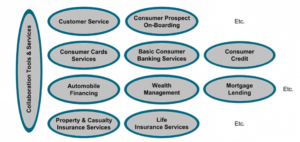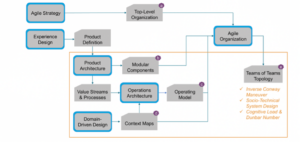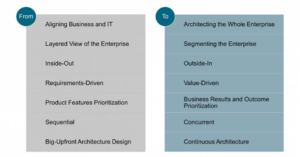In the previous part, we looked at the building blocks as the technical and social systems of an enterprise. In this blog, we’ll go into three aspects of architecture decision-making that support the building blocks mentality: enterprise decomposition, the segmentation approach, and mental model shifts.
Enterprise decomposition
Decomposing an enterprise is a key architecture decision. It’s not an easy one though, since it involves changes to the enterprise’s hierarchy. Hierarchy, in this sense, refers to the different levels of complexity in an organisation’s structure. Let’s illustrate this with another example: a universal bank.
- At the top level, this universal bank has three business lines: retail banking, wholesale banking, and global markets.
- At the second level, customer segments can decompose the retail bank into three more business lines: consumer, small business, and enterprise.
- At the third level of decomposition, customer segments and product logic are mixed. The figure below illustrates that levels should not be confused with layers.
In this example, the way we decompose retail banking has far-reaching implications. Each bubble in the figure above represents a modular part of the business, which can operate in relative autonomy from the other parts. The few dependencies that remain are identified, standardised, and managed. For example, consumer prospect onboarding will order credit cards for new customers.
The segmentation approach
As we just saw, enterprise decomposition sometimes requires segmentation. The figure below is a high-level example of how we can approach segmentation in an organisation. The highlighted rectangles represent some of the building blocks of our diagram, and the arrows represent direct links between those building blocks and their resulting work products.
When converted into text, here’s what this figure means:
- The Agile strategy influences an enterprise’s top-level organisation (a). The business lines and corporate functions are defined or adjusted to support the enterprise’s strategic direction.
- Experience design discovers and defines the products that meet the different client segments’ needs.
- Product architecture then explores the trade-off between modularity and integrality. It defines how to compose products into modular components (b) and identifies possible product platforms.
- Operations architecture specifies the value streams and processes that deliver products and design the operating model (c).
- Domain-driven design decomposes a domain into bounded contexts, which are organised into context maps (d). These context maps define the patterns that link the bounded contexts.
- The Agile organisation receives input from the modular components that compose products, the operating model, and the context maps.
- The Agile organisation decomposes the top-level organisation into a team of teams topology (e) guided by four aspects:
- The Inverse Conway Manoeuvre, which advocates shaping an organisation so that communication lines mirror intentional architecture boundaries.
- The socio-technical system design, which proposes designing the technical and social subsystems concurrently.
- The Dunbar number, which represents a cognitive limit: the maximum number of people with whom one person can maintain stable social relationships.
Mental model shifts
Decomposing and segmenting an enterprise and shifting to an Agile architecture requires a change in mentality. Without sufficient change management, such a far-reaching transformation cannot be successful. The following mental shifts are needed:
Conclusion
We hope that you now have a better understanding of the Open Agile Architecture way of working. By integrating the social and technical systems, O-AA takes the Agile approach several steps further than just software development. Our approach uses extensive decomposition and segmentation strategies coupled with a shift in mentality to achieve a thorough organisational transformation. In doing so, we integrate all aspects of a business.
Of course, this is just a glimpse of what O-AA can accomplish for your organisation. While its possibilities excite us, explaining all of its intricacies would be nearly impossible. That’s why it’s necessary to let a trusted partner help you with important changes such as these.


